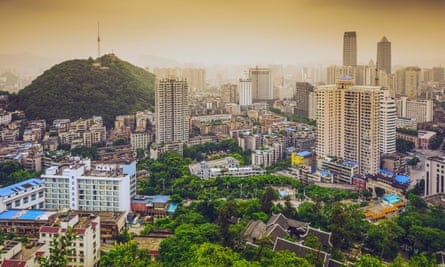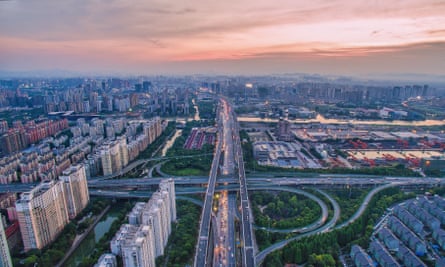China now has more than 100 cities of over 1 million residents, a number that is likely to double in the next decade.
According to the Demographia research group, the world’s most populous country boasts 102 cities bigger than 1 million people, many of which are little known outside the country – or even within its borders.
Quanzhou, for example, on the south-east coast of China, was one of the most cosmopolitan cities in the world a millennium ago, when it served as a hub for traders from across Asia and the Middle East. It is now home to more than 7 million people, nearly 800,000 more than Madrid.
But while Madrid is a cultural powerhouse and the centre of Spanish politics, Quanzhou, with its 1,000-year-old mosque and charming cafes, is rarely discussed even within Chinese media, whereas Beijing, Shanghai and Hong Kong continue to get most of the headlines.
Outside China, meanwhile, few will even have heard of Kaifeng, a former imperial capital that was once a terminus on the Silk Road, or Weihai, both cities bigger than Liverpool (estimated population of urban area 880,000).

The scale of China’s urban ambitions is staggering: it now has 119 cities bigger than Liverpool. By 2025, according to a report by the McKinsey Global Institute, that number is predicted to have more than doubled.
One reason is that the government is actively encouraging rural residents to urbanise. China aims to have 60% of its people living in cities by 2020, up from 56.1% currently, and the World Bank estimates a billion people – or 70% of the country’s population – will be living in cities by 2030.
Thousands of government officials have campaigned across the country to convince farmers to move to newly built urban districts, turning centuries-old villages into ghost towns.
Another factor? China’s centre is moving west. Guiyang, for example, topped a few lists of the best-performing Chinese city last year, as the once-sleepy capital of the country’s poorest province saw a boom in cloud computer servers and telecommunications, with e-commerce giant Alibaba a major investor.
Factories are moving inland from the coastal regions in droves. Xiangyang and Hengyang, both now home to more than 1 million people, are swelling as low-end manufacturing moves to cities with cheaper labour.
The local government in Zhengzhou, for its part, transformed a dusty patch of land in central China into an industrial park overnight; Foxconn, the world’s largest contract electronic manufacturer, now makes about half of all iPhones there and has also built a plant in Hengyang.

Meanwhile, as factories flee the expensive coasts, others have been forced to the traditional manufacturing hub of Guangdong province, especially in industries such as textiles and low-end electronics.
This shift to cities is unprecedented in modern Chinese history. For decades, the ruling party wanted to keep rural residents out of cities. They used a household registry system – known as a hukou – that meant people could only receive healthcare, education and other social services in the location where they were registered. Now, however, officials eager to entice farmers into cities are offering them an urban registration with the promise of better benefits.
The result is that urban centres of all sizes are forecast to grow, and by 2025 China will have 221 cities with a population of at least 1 million, according to the consultancy firm McKinsey. That will mean an explosion in construction of buildings, roads and transport systems.
Many people worry that many of these newly minted metropolises will lose their character – the Chinese government has set a target for 30% of buildings to be prefabricated in the next 10 years.
Newly built apartment blocks already have a cookie-cutter feeling, with identical 30-storey buildings visible from the window of nearly every high-speed train ride. The uniform construction can create an eerie scene, one city indistinguishable from the next.

Merging cities
Measuring the population of a city in China is not an exact science. Chinese cities often administer sizeable rural areas beyond the city centre and surrounding suburbs, and the Chinese word for city – shì or 市 – is typically used to describe a sub-provincial region. Rolling mountains and hundreds of miles of the Great Wall lie within Beijing’s official boundary, for instance, and nearly all Chinese municipalities contain at least one rural county within the city limits.
In one extreme example, Chongqing municipality covers an area almost the size of Austria, but the urban area covers only about a quarter of that, according to Demographia. Analysis shows that while the total population living within the city limits is close to 50 million, only about 7.4 million people live in the urban area.
Another issue is that Chinese cities are growing so large that it has become difficult to determine where one begins and another ends. Guangzhou, formerly known as Canton, has an underground line that snakes into the neighbouring city of Foshan. Does that make it one city or two?
The government is currently attempting to tie Beijing with two neighbouring regions, the city of Tianjin and Hebei province, to create the megacity of Jing-Jin-Ji. In a sign of how serious the authorities are about integrating the three regions, the government recently approved a £29bn railway to improve transport links. The resulting megacity will have a combined population of more than 100 million, and cover an area twice the size of South Korea.
Guardian Cities is dedicating a week to the huge but often unreported cities on the front line of China’s unprecedented urbanisation. Explore our coverage here and follow us on Facebook. Share stories via WeChat (GuardianCities) and by using #OtherChina on Twitter and Instagram
Comments (…)
Sign in or create your Guardian account to join the discussion